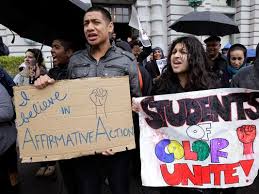The U.S. Supreme court gives equal rights to white students
Wednesday, April 23rd, 2014 1:59:58 by Kashif Mirza
The U.S. Supreme Court has endorsed the suspension of affirmative action in public universities in Michigan. The decision, announced Tuesday, gives the reason the state and opens the way for others to suspend one of the laws that were used to promote the access of racial minorities to higher education.
The State of Michigan rejected in a referendum the use of affirmative action, known as ” affirmative action” and which was passed in the early 60s to ensure that students of racial minorities and less affluent have place in public universities throughout the country. The referendum, with 58 % of votes in favor, amended the state constitution to prohibit schools that consider race as a factor in deciding whether to admit a student.
The Supreme has been endorsed by six justices against two – Judge Elena Kagan had recused from the case because he had worked on it during its passage through the Department of Justice. The ruling does not override the constitutionality of affirmative action, but recognizes the right of citizens to prohibit its application through a referendum. From now, universities will remove this measure, despite its success, has always been attacked by the most conservative considering that white students were being harmed.
The wording reflects the division sentence raised by this law, and the judges who voted in favor of the State of Michigan have presented three different views. ” This is not how we resolve the debate of racial preferences,” wrote Justice Anthony Kennedy, ” but who should solve it.” According to Kennedy, this competition is for the citizens themselves. The judge also argues that Americans can now prefer the elimination of racial profiling by ” resentment ” awakening.
The most liberal member of the court, Sonia Sotomayor and Ruth Ginsburg, voted against the decision. In his view, the decision to reject Michigan considering it “a blow against historically discriminated groups who rely on the federal courts to protect their constitutional rights.”
” Without controls, democratically adopted laws can oppress minorities,” Sotomayor writes in its judgment, supported by Ginsburg. ” [ The judges ] can not sit waiting for a change but must confront racial inequality in our society.” The judges argue that this case is an example of the limits necessary to protect minorities and ensure their equality before the law. “The Constitution does not protect racial minorities from political defeats,” Sotomayor incident. ” But neither delivery to most selective right to erect barriers against minorities.”
Judge Sotomayor has claimed on numerous occasions that she agreed to Princeton University due to affirmative action, through a program urging the incorporation of Hispanic youth, and has openly defended its validity. Conservative Justice Clarence Thomas, an African American, has also granted his access to Yale was due to this measure. However, it is in favor of removal.
In recent years, several lawsuits have tried to eliminate affirmative action on the grounds that it is no longer necessary. In 2012, the Supreme studied the case of a student from Texas who claimed to have been left out of a university place because priority was given to minority students. On that occasion, the judges decided that a court of lower rank checking back the sentence, although they acknowledged that the legislation could face future changes, coinciding with the demographic change in the country.
Short URL: https://www.newspakistan.pk/?p=43155

















